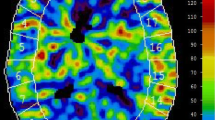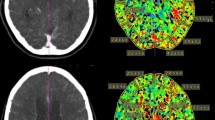Summary
Ninety-six patients with aneurysmal subarachnoid haemorrhage underwent serial measurement of regional cerebral blood flow throughout the period of their treatment over the period of 5 years (1983 to 1988). A portable bedside xenon cerebral blood flow machine was used in this study and the initial slope index (ISI) values showed a clear relationship between reduction of cerebral blood flow and deteriorating clinical grade. Furthermore, serial measurements showed a statistically significant relationship between drop of cerebral blood flow, at anytime during the course of the disease, and fatal or less than satisfactory outcome.
Similar content being viewed by others
References
Agnoli A, Prencipe M, Priori AM, Bozzo L, Fieschi C (1969) Measurement of rCBF by intravenous injection of 133 Xe: A comparative study with intra-arterial injection method. In: Brock M, Fieschi C, Ingvar DH, Lassen NA, Schurman K (eds) Cerebral blood flow. Springer, Berlin Heidelberg New York, pp 31–34
Austin G, Horn N, Rouhe S, Hayward W (1972) Description and early results of an intravenous radioisotope technique for measuring regional cerebral blood flow in man. Eur Neurol 8: 43–52
Bergvall V, Steiner L, Forster DMC (1973) Early pattern on cerebral circulatory disturbances following subarachnoid haemorrhage. Neuroradiol 5: 24–32
Botterell ER, Lougheed WM, Scott JW, Vandewater SL (1956) Hypothermia and interruption of carotid or carotid and vertebral circulation. In: The surgical management of intracranial aneurysms. J Neurosurg 13: 1–42
Compton JS, Redmond S, Symon L (1987) Cerebral blood flow velocity in subarachnoid haemorrhage: A transcranial Doppler study. J Neurol Neurosurg Psychiatry 50: 1149–1503
Ecker A, Riemenschneider PA (1951) Arteriographic demonstration of spasm of the intracranial arteries: With special reference to saccular arterial aneurysms. J Neurosurg 8: 660–667
Heilbrun NP, Olesen JU, Lassen NA (1972) Regional cerebral blood flow in studies in subarachnoid haemorrhage. J Neurosurg 37: 36–44
Hunt WE, Hess RM (1968) Surgical risk as related to time in intervention in the repair of intracranial aneurysms. J Neurosurg 28: 14–20
Ingvar DH, Lassen NA (1961) Quantitative determination of regional cerebral blood flow in man. Lancet 2: 806–807
Jabre A, Symon L, Redmond S (1985) A comparative study of the portable regional CBF monitor and portable mean hemispheral CBF monitor: Advantages and disadvantages in clinical practice. Acta Neurochir (Wien) 77: 142–145
Jakubowski L, Bell BA, Symon LO, Zawirski M, Francis DM (1982) A primate model of subarachnoid haemorrhage: Change in regional cerebral blood flow, autoregulation, carbon dioxide reactivity and central conduction time. Stroke 13: 601–611
Jennett B, Bond M (1975) Assessment of outcome after sever brain damage: A practical scale. Lancet 1: 480–484
Kelly PJ, Goiten RJ, Rose JE, Grossman RG (1980) Cerebral infarction and ruptured intracranial aneurysms. In: Wilkins RH (ed) Cerebral arterial spasm. Williams & Wilkins, Baltimore, pp 366–371
Kety SS, Schmidt CF (1945) The determination of cerebral blood flow in man by the use of nitrous oxide in low concentrations. Am J Physiol 1: 1081–1082
Mallet BL, Veall N (1963) Investigation of cerebral blood flow in hypertension using xenon inhalation and extracranial recording. Lancet 1: 1081–1082
Merory J, Thomas DJ, Humphrey PRD, Du Boulay GH, Marshall J, Ross Russel RW, Symon L, Zilkha E (1980) Cerebral blood flow after surgery for recent subarachnoid haemorrhage. J Neurol Neurosurg Psychiatry 43: 214–221
Nibbelink DW, Tormer JC, Henderson WG (1977) Intracranial aneurysms and subarachnoid haemorrhage — report on a randomized treatment study. Stroke 9: 202–218
Obrist WD, Thompson HK Jr, King CH, Wang HS (1967) Determination of regional cerebral blood flow by inhalation of 133-xenon. Circ Res 20: 124–135
Obrist WD, Thompson HK Jr, Wang HS, Wilkinson WE (1975) Regional cerebral blood flow estimate by xenon-133 inhalation. Stroke 6: 245–256
Pakarinen S (1967) Incidence, aetiology and prognosis of primary subarachnoid haemorrhage: a study based on 589 cases diagnosed in a defined urban population during a defined period. Acta Neurol Scand [Suppl] 29: 1–128
Pickard JD, Matheson M, Paterson J, Wyper DJ (1980) Autoregulation of cerebral blood flow and the prediction of late morbidity and mortality after cerebral aneurysm surgery. In: Wilkins RH (ed) Cerebral arterial spasm. Williams & Wilkins, Baltimore, pp 350–355
Richards PG, Tsutsui T, Symon L, Jabre A, Rosenstein J, Redmond S (1986) Comparison of fast flow and initial slope index values for cerebral blood flow following subarachnoid haemorrhage. J Neurol Neurosurg Psychiatry 49: 431–434
Risberg J (1980) Regional cerebral blood flow measurements by xenon-133 inhalation: Methodology and applications in neuropsychology and psychiatry. Brain Lang 9: 9–34
Risberg J, Ali Z, Wilsom EM, Wills EL, Halsey JH (1975) Regional cerebral blood flow by xenon-133 inhalation. Stroke 6: 142–148
Rosenstein J, Suzuki M, Symon L, Redmond S (1984) Clinical use of portable bedside cerebral blood flow, machine in the management of aneurysmal subarachnoid hemorrhage. Neurosurg 15: 519–525
Rosenstein J, Wang AD, Symon L, Suzuki M (1985) Relationships between hemishperic cerebral blood flow, central conduction time, and clinical grade in aneurysmal subarachnoid haemorrhage. J Neurosurg 62: 25–30
Rousseaux P, Scherpereel B, Bernard MHY, Graftieaux JP, Guyot JF (1980) Fever and cerebral vasospasm in ruptured intracranial aneurysms. Surg Neurol 14: 459–465
Sahs AL, Perret GE, Locksley HB, Nishioka H (eds) (1969) Intracranial aneurysms and subarachnoid haemorrhage. A cooperative study. Lippincott, Philadelphia
Smith RR, Yoshioka F (1985) Intracranial arterial spasm. In: Wilkins RH, Rengachary SS (eds) Neurosurgery. McGraw-Hill, New York, pp 1355–1362
Symon L, Compton J, Redmond S, Rosenstein J, Momma F (1988) Bedside monitoring in subarachnoid haemorrhage: Evoked responses, hemispheral blood flow and flow velocity measurements. In: Wilkins RH (ed) Cerebral vasospasm. Raven Press, New York, pp 73–78
Symon L, Pasztor E, Dorsch NWC, Branston NM (1973) Physiological responses of local areas of the cerebral circulation in experimental primates determined by the method of hydrogen clearance. Stroke 4: 632–642
Thomas DJ, Zilkha E, Redmond D, Du Boulay GH, Marshall J, Russell RWR, Symon L (1979) An intravenous xenon-133 clearance technique for measuring cerebral blood flow. J Neurol Sci 40: 53–63
Weir B (1985) Intracranial aneurysms and subarachnoid haemorrhage: An overview. In: Wilkin RH, Rengachary SS (eds) Neurosurgery. McGraw-Hill, New York, pp 1308–1329
Author information
Authors and Affiliations
Rights and permissions
About this article
Cite this article
Kotb, M.M.W., Symon, L., Compton, J. et al. Grading and outcome prediction of cases of aneurysmal subarachnoid haemorrhage by bedside xenon cerebral blood flowmetry. Acta neurochir 108, 1–6 (1991). https://doi.org/10.1007/BF01407659
Issue Date:
DOI: https://doi.org/10.1007/BF01407659




